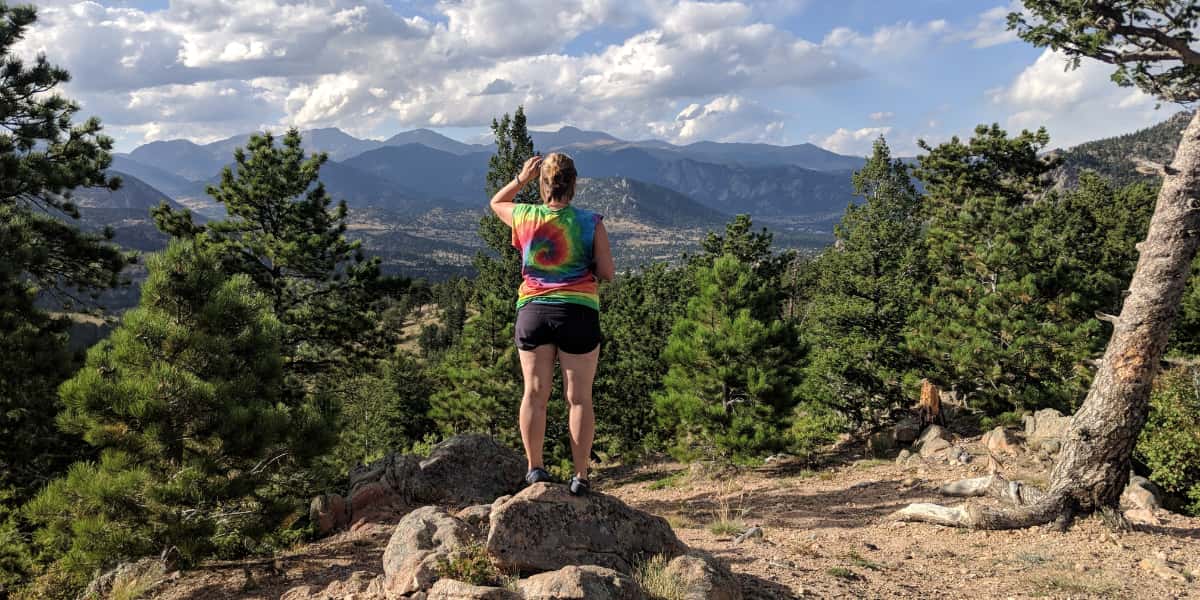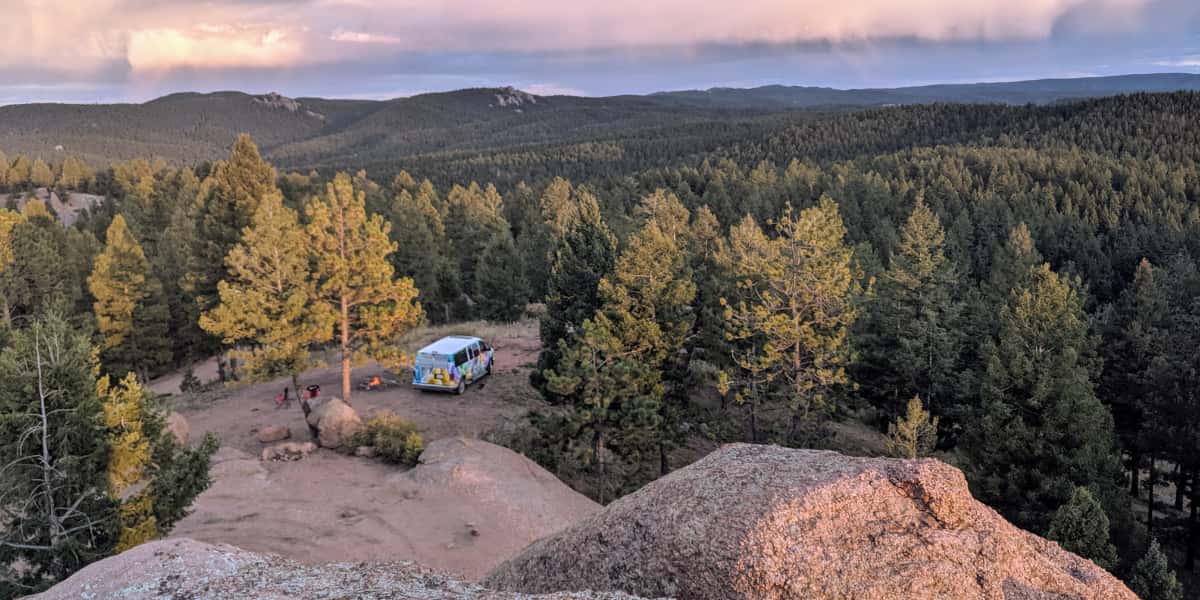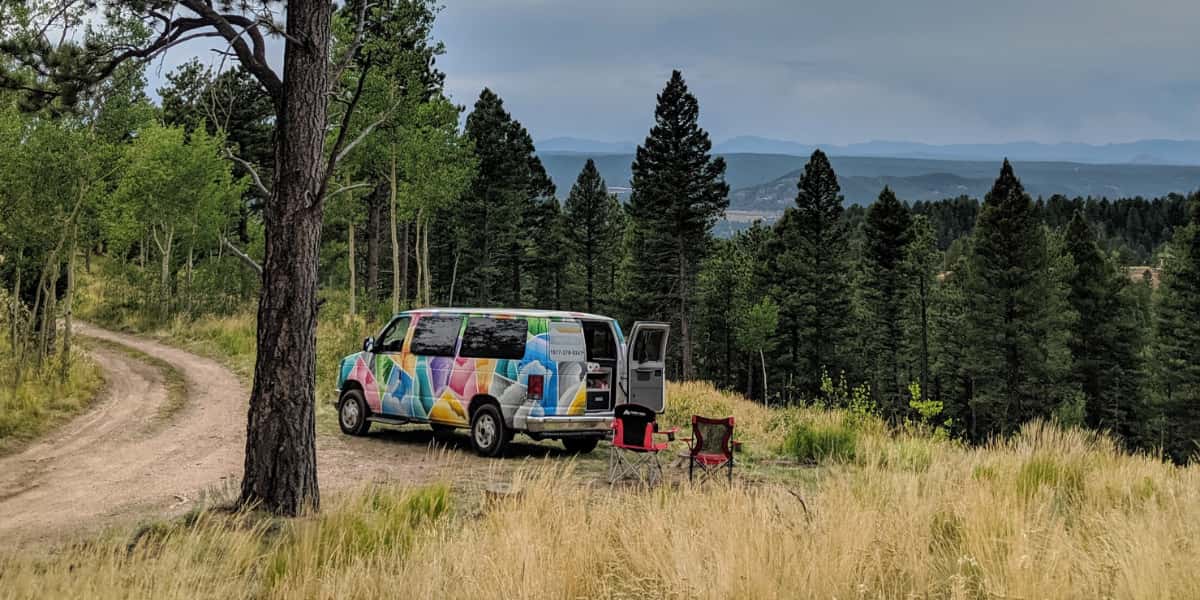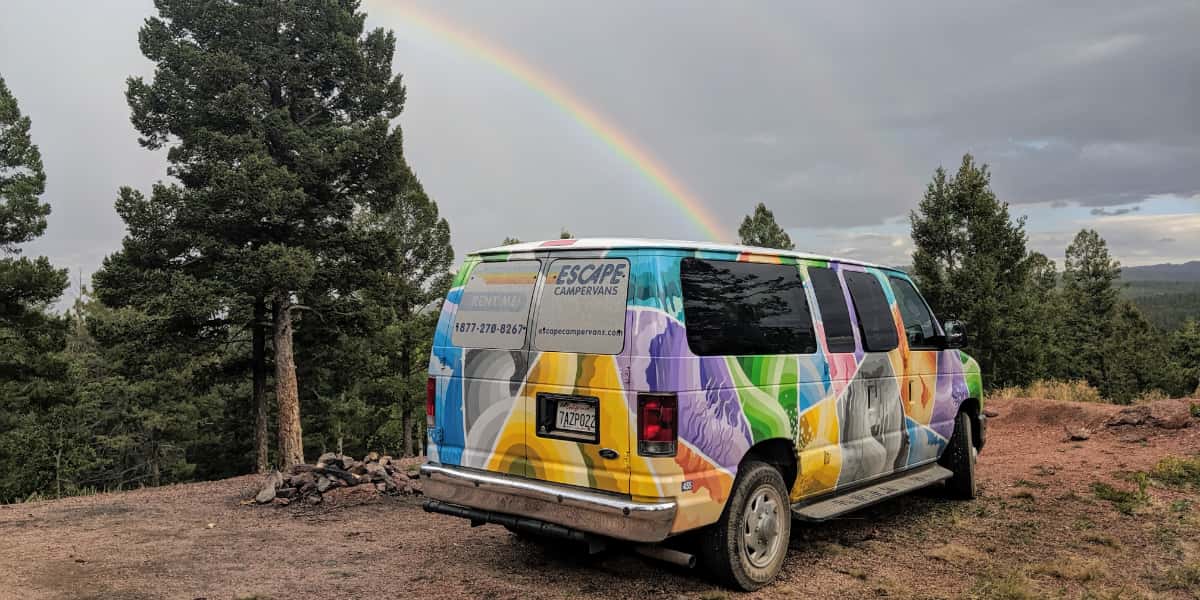Stephanie Ham
As I began to prepare for my first campervan rental with Escape back in 2019, I came across their blog about dispersed camping, and my mind was blown to learn that we would be able to camp for WEEKS (at least) for free. Free, people! No charge!
We ultimately camped for free for 6 out of 7 nights, choosing to pay for one night in a campground mid-week to grab a much-needed shower. Dispersed camping has opened a whole new world of camping for my family, freeing up our budget to focus on local activities, food, and beverages, and has encouraged us to explore new areas we hadn’t previously considered.
What IS Dispersed Camping, Anyway?
Dispersed camping, also commonly referred to as boondocking, is basically any camping that takes place outside of an organized or designated campground. Dispersed camping is typically available on State and Federally owned public lands. This includes Bureau of Land Management (“BLM”) lands, US Forest Service (“USFS”) lands, which include National Forests and Grasslands, and State Department of Conservation or Forestry lands. All of these options mean that you can camp free of charge at thousands of locations across the country.
What it ISN’T:
Dispersed camping is not glamping. It’s going to be a no-frills experience – there are no services such as trash removal, outhouses, or water. There are frequently no picnic tables, either, although you will often find a rustic fire ring made of stones. You’ll need to take appropriate precautions when toileting in the woods to minimize your impact on the land and pay attention to any active fire restrictions in your area. In exchange, you will often have unobstructed views, no neighbors, and nearby access to the coolest trailheads and natural features.
What Are The Rules?
Unless there are signs stating otherwise, you are allowed to sleep in your vehicle on federally designated lands. However, rules and expectations still exist – and, in fact, are critical to ensure conservation of the plant and animal resources that call these areas home.
According to the USFS, some common rules on Forest Service Land include:
- You may camp in a dispersed area for up to 16 days. After 16 days, you must move at least 5 road miles for camping in another dispersed area. Campers may not spend more than 16 days of any 30-day period at the same dispersed area.
- Please place your campsite at least 100 feet from any stream or other water source.
- Keep a Pack-In Pack-Out camp. Follow Leave No Trace guidelines.
- Contact the local Forest Service office to see if any restrictions, especially fire restrictions are in place.
Rules on BLM land are very similar, although you will need to relocate to a new site after 14 days within a 28 consecutive day period. After the 14th day of occupation, you must move outside of a 25-mile radius of the previous location until the 29th day since the initial occupation.
Free Camping Is Easier In A Campervan!
If all of that sounds daunting – it’s really not, promise. With research, preparation, and the right vehicle, you’ll be well on your way to being a seasoned pro in no time. A campervan makes dispersed camping easy, accessible, and low maintenance. An Escape Campervan is like a mini, maneuverable RV – containing many of those amenities that dispersed sites usually lack. In your Escape Campervan or Jeep, you’ll easily access small, remote sites that a larger RV would never be able to fit into. Find a beautiful spot and park – and you’ll already have your bed, table, and kitchen right there – no equipment set up or gear-hauling needed.
Free Camping In National Parks
Most camping in national parks is required to be in designated campgrounds, and all camping will typically require a permit. Typically, the National Park Service uses the term “backcountry” camping, instead of dispersed. Backcountry sites may not be in a popular or scenic area of the park, and sometimes are walk-in or hike-in tent sites, as opposed to sites that are suitable to access with a campervan. All this being said, vehicle backcountry camping is offered at Big Bend National Park ($10 permit required) and Death Valley National Park (free, but proceed with caution!).
The National Park Service also operates some National Recreation Areas (NRAs), which offer a few more boondocking opportunities. You might try Glen Canyon NRA (Utah), Lake Mead NRA (Nevada), or Lake Meredith NRA (Texas).
The good news is that, although free camping opportunities are admittedly limited inside National Parks proper, National parks are very frequently surrounded by National Forest land – where you will very likely have success finding a great free site!
Free Camping On Federal Public Land (USFS Or BLM):
The vast majority of free sites that I have camped on have been in National Forests, which are owned by the US Forest Service (USFS). These sites are often marked, although not always, and are usually along fairly well-maintained, hard-packed gravel roads. Make sure you have done your research, as we’ll discuss below, to ensure there are several different sites available when targeting an area– these are all first-come, first-served, so you may need to drive past a few to find one that is available.
Free Camping On Private Land:
Occasionally, whether it be due to time of day, or a lack of availability, you just may not score a sweet free site that day. Never fear – options remain. Highway truck stops, state rest areas, or commercial parking lots will frequently allow overnight parking. Look for signs that designate specific areas or, when in doubt, ask an employee or manager, if available. Many of the sites below will also identify these types of areas where boon-dockers have had success in the past.
But How Do I Find A Site?
This is where a little research will go a long way. Spend time with Google maps prior to your trip, paying close attention to those green-shaded areas. What National Parks, Forests, or state conservation areas are near your destination? Are there any Wildlife Conservation areas? Once you’ve identified some publicly owned lands near you, you can contact the relevant authority to get a physical or digital map, which will typically identify the areas where dispersed camping is permissible, including the name or number of the road.
5 Websites Or Apps To Find A Free Campsite:
- US Forest Service Activity Search: Select “dispersed camping” from the activity list and then select the Forest or Grassland you are targeting (if not shown, dispersed camping is likely not permitted in that particular land). Click through to the Forest or Grassland page, where it should tell you precisely which Forest Road the dispersed sites will be located on (typically labeled by number, for example, FS119). Maps can then be downloaded from the website or picked up from a Forest Service office. Or contact a Forest Ranger!
- Freecampsites.net: This is an awesome site that will allow you to search via map for both free and paid sites near you. This site will identify both public dispersed camping as well as areas such as truck stops, parking lots, etc. You will often find user-submitted photos of areas as well as good information about the condition of the road and what types of vehicles will be able to access the site. Take the time to read the reviews as sometimes users will comment if an area has been closed.
- The Dyrt: Thedyrt.com will allow you to search by location, “near me” and by date to identify both designated campgrounds and free sites. Just select “dispersed” from the list of filters to see only those sites that are free of charge.
- Boondocking.org: Boondocking.org will allow you to search via map to identify free campsites. All campsites on this app should be free (bearing in mind that things do change as lands occasionally change ownership or stewardship!)
- Campendium.com has a feature on their site to search for free campsites. They frequently feature Top Free Campgrounds and have a handy map pre-populated with free campsites.
- State government website: Visit the official website of the state you are visiting and look for their Department of Conservation or Bureau of Land Management. You may not find free sites as consistently as you do on Federally owned land, as laws and rules vary from state to state, but many do offer first-come, first-serve sites on state-owned conservation lands.
Get Out There And Camp For FREE In The US In A Campervan!
With Escape depots strategically located near some of the most densely federally managed lands, there is no better way to get out and explore the US backcountry than in an Escape Campervan. Book a campervan today and start exploring the US!


 Call Us
Call Us




